May 5, 2014: City Council Preview
The Ann Arbor city council’s voting agenda for its May 5, 2014 meeting is relatively light, but features some significant public hearings and a potentially controversial contract related to footing drain disconnections.

Screenshot of Legistar – the city of Ann Arbor’s online agenda management system. Image links to the May 5, 2014 meeting agenda.
One public hearing will be held on the FY 2015 budget. The 2015 fiscal year starts on July 1, 2014. City administrator Steve Powers presented his proposed budget to the council at its previous meeting, on April 21. The council will take up possible amendments and vote on the adoption of the budget at its following meeting, on May 19.
A separate budget-related public hearing on May 5 will be held on fee increases in the community services area. Notable is the proposed increase in the fees for stalls at the farmers market. The annual fee for one stall will increase from $300 to $450.
A significant voting item on the agenda is a roughly $750,000 contract with CDM Smith Inc. for continued work in connection with the city’s footing drain disconnection (FDD) program. In 2012, the city’s program to disconnect footing drains from the sanitary sewer system was suspended by the council in some areas of the city. It has continued in other geographic areas and as part of the city’s developer offset mitigation program, which requires owners of new developments to complete a certain number of FDDs. The purpose is to offset the additional flow in the sanitary system caused by new construction.
The CDM contract could draw scrutiny, because the city is currently undertaking a sanitary sewer wet weather evaluation (SSWWE) study. It’s supposed to yield a recommendation about whether to continue with the FDD program, and if so, in what form. In addition, the city’s ordinance, which requires property owners to undertake FDDs, was challenged in a lawsuit filed earlier this year. That case is pending as the city has removed the case from state to federal court and the plaintiffs are seeking to remand it back to state court. A hearing is scheduled for May 28 on the question of remand.
Also on the agenda are two contracts for general construction inspection work, each for $100,000, with Stantec Inc. and Perimeter Inc.
Three parks will be getting upgrades to play equipment if the council approves a contract with Game Time c/o Sinclair Recreation for $132,000. Arbor Oaks Park and Scheffler Park will have their play structures replaced, and North Main Park will be getting a tire swing and chess table.
Mowing and snow clearance in city parks in the future be handled with two mower/snow-broom combination units, if the council approves the purchase from Spartan Distributors for $101,000.
Three land-use items that were recommended for action by the city planning commission appear on the council’s May 5 agenda.
First, the council will consider giving initial approval to a change in the city’s zoning ordinance related to drive-thrus. In addition to providing a definition, the ordinance revision would require drive-thrus to obtain special exception use permits, which would be allowed only in the O (office), C2B (business service) and C3 (fringe commercial) zoning districts. Drive-thrus would not be allowed in the C1, D1, D2, and other commercial districts. Currently, drive-thrus are allowed in C3 districts without a special exception use. They are allowed as special exception uses in the C2B district.
Second, the council will consider giving initial approval to a rezoning request and area plan for 515 Oxford, to convert a house for use as an annex to the Delta Gamma sorority. The main sorority house is located nearby at 626 Oxford. The request, supported by the city’s planning staff, is to rezone the parcel from R4A (multi-family dwelling) to R2B (two-family dwelling and student housing).
And third, the council will consider final approval for the rezoning of land that’s been donated to the city by developer Bill Martin, founder of First Martin Corp. The 2.2-acre parcel at 3301 Traverwood Drive is being added to the adjacent Stapp Nature Area, near the Leslie Park golf course.
Sidewalks are again on the agenda in the form of a public hearing on the proposed Newport Road special assessment, which is supposed to help fund a stretch of sidewalk north of Wines Elementary School. And the council will consider the acceptance of an easement for a sidewalk at 2300 Traverwood Drive.
The council will also consider a routine item this time of year – transferring delinquent water utility, board-up, clean-up, vacant property inspection, housing inspection fees, and fire inspection invoices to the city tax roll for July 2014. The council will also be asked to approve the denial of claims against the city by the board of insurance administration.
Management of the deer population will receive some attention in the form a resolution on the May 5 agenda that directs the city administrator to partner with other organizations to develop strategies for deer management. The administrator will be asked to report back to the city council by July 31, 2014 on the status of the partnership, including budget and timelines. The resolution, put forward by Jane Lumm (Ward 2), states that the desired outcome is a community-endorsed deer management plan.
Appointments to the city’s environmental commission (EC) are on the May 5 agenda, having been postponed at the council’s April 21 meeting. All three that appeared on the April 21 agenda were re-appointments for currently serving members of the EC: Kirk Westphal, David Stead, and Susan Hutton. However, the intention at the May 5 meeting is to substitute the original resolution with one that does not include Stead.
Street closings on the agenda include: East Washington for the Ann Arbor Book Festival on June 21; East Liberty for Sonic Lunch on Aug. 21; and several neighborhood streets for the 2014 Glacier Area Homeowners Association Annual Memorial Day Parade on May 26.
This article includes a more detailed preview of many of these agenda items. More details on other agenda items are available on the city’s online Legistar system. The meeting proceedings can be followed Monday evening live on Channel 16, streamed online by Community Television Network starting at 7 p.m.
Public Hearings
On the May 5 agenda are two public hearings related to the upcoming 2015 fiscal year, which starts July 1, 2014: the proposed FY 2015 budget; and proposed fee changes in the community services area – for the farmers market.
Public Hearing: FY 2015 Budget
Though the budget’s public hearing is on May 5, council action to adopt that budget, with any amendments, will come at the council’s second meeting of the month, on May 19. Ann Arbor city administrator Steve Powers’ proposed general fund budget for fiscal year 2015, which starts on July 1, 2014, approaches $100 million. [.pdf of FY 2015 budget detailed breakdown]
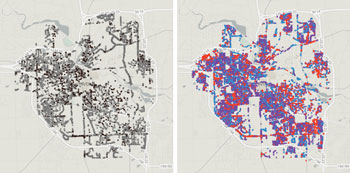
Left: Tree stumps (black) and vacant sites (gray). Right: Maples (purple), crabapples (red) and oaks (blue). Maps by The Chronicle from the city’s 2009 tree inventory. The city administrator’s proposed FY 2015 budget includes a one-time $1 million expense to address the backlog in pruning and removal of trees that are dead or in poor condition.
Funded as part of the proposed FY 2015 budget are five new full-time employees, four of them in public safety: one additional firefighter; three additional police officers; and an additional rental housing inspection position. The additional police positions will bring the total number of sworn officers in the city of Ann Arbor to 122.
The proposed budget also includes a one-time expense of $1 million to address a backlog in critical pruning and removal of trees that are in the public right of way. The allocation comes in the context of the development of an urban forestry management plan.
The $1 million one-time expense for street trees brings the total of non-recurring expenses in the FY 2015 general fund budget to about $2.8 million. Other one-time expenses budgeted for FY 2015 are: $80,000 to cover transitional costs for art administration; $606,000 for repairs and maintenance of the city’s hydroelectric dams; $100,000 for consultants to assist with completing the downtown zoning amendments and sign inventory; $300,000 for demolition of city-owned buildings at 415 W. Washington; $200,000 for corridor studies; and $209,000 in operational support for the Ann Arbor Housing Commission’s (AAHC) transition to a rental assistance demonstration program.
The housing commission also accounts for the bulk of a $13.8 million (17%) increase in general fund recurring expenditures compared to last year. That’s due to an accounting change that recognizes 22 AAHC employees as city employees. By recognizing revenue and expenses for AAHC employee compensation through the general fund, the AAHC can avoid the negative impact of a new accounting rule. The GASB 68 rule requires unfunded pension fund liabilities to be recorded in the financial statements for proprietary funds (like the AAHC) but not for governmental funds like the general fund.
Also included in the FY 2015 budget proposal is about $3,000 for a pilot program for closed captioning of public meeting broadcasts on the Community Television Network. According to city of Ann Arbor communications manager Lisa Wondrash, the cable commission recommended approval of the money at its Feb. 25 meeting, and she notified the commission on disability issues about the pilot on April 16. The pilot will begin with meetings of the city’s commission on disability issues, with a goal of testing out a closed captioning system this July.
The $98.1 million of general fund expenditures in FY 2015 will include $95.3 million in recurring expenditures and $2.8 million in one-time expenses.
When the general fund is added in with the rest of the city’s budget – the street fund, water fund, sewer fund, parking fund, and the like – the total expenses proposed for FY 2015 come to $334,434,101.
Powers presented the proposed budget to the city council at its April 21 meeting.
Public Hearing: FY 2015 Community Service Fees
At the May 5 council meeting, increases are being proposed for stall fees at the Ann Arbor public market (farmers market). Currently, the basic annual fee for rental of a stall is $300. It’s proposed to be increased to $450 – a 50% increase.
If approved by the council, the fee increase would be projected to generate $26,000 in additional revenue. However, this additional revenue has not been assumed in the proposed FY 2015 budget.
According to the staff memo accompanying the agenda item, “market fees were last increased in 2009 and have not kept pace with the overall increase of annual operating costs during this same time period.” A comparative analysis of Ann Arbor’s fees also showed that Ann Arbor’s fees are well below those of comparable markets.
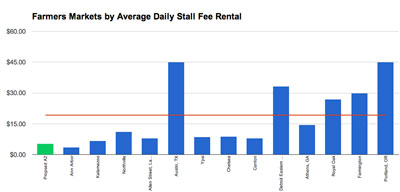
Comparative chart of stall rental rates, including three in other states. Ann Arbor’s current rate is the leftmost blue bar. Ann Arbor’s proposed market stall rental rate is shown in green. The red horizontal line is the average. (Chart by The Chronicle with data from the city of Ann Arbor.)

Comparative chart of stall rental rates, excluding those in other states. Ann Arbor’s current rate is the leftmost blue bar. Ann Arbor’s proposed market stall rental rate is shown in green. The red horizontal line is the average. (Chart by The Chronicle with data from the city of Ann Arbor.)
FDD Contract
A significant voting item on the agenda is a roughly $750,000 contract with CDM Smith Inc. for continued work in connection with the city’s footing drain disconnection (FDD) program. In 2012, the city’s program to disconnect footing drains from the sanitary sewer system was suspended by the council in some areas of the city. Specifically, it was suspended in the Glen Leven and Morehead (Lansdowne neighborhood) areas. It was allowed to continue in other geographic areas and as part of the city’s developer offset mitigation (DOM) program. The DOM requires owners of new developments to complete a certain number of FDDs to offset the additional flow in the sanitary system caused by new construction.
The CDM contract could draw scrutiny, because the city is currently undertaking a sanitary sewer wet weather evaluation (SSWWE) study. It’s supposed to yield a recommendation about whether to continue with the FDD program, and if so, in what form. In addition, the city’s ordinance, which requires property owners to undertake FDDs, was challenged in a lawsuit filed earlier this year. That case is pending as the city has removed the case from state to federal court and the plaintiffs are seeking to remand it back to state court. A hearing is scheduled for May 28 on the question of remand.
One indication that the item is expected to be scrutinized is the fact that in the last week of April, city administrator Steve Powers offered to set up meetings between staff and councilmembers to discuss the resolution. The resolution is perceived by some as an indicator that the sanitary sewer wet weather evaluation (SSWWE) would have a forgone conclusion that the FDD should continue. However, at more than one meeting of the advisory committee that’s working on the study, staff and consultants have indicated that if the FDD were to continue at all, it would almost certainly not continue in its current form.
And the staff memo seems to anticipate possible questions by stressing that until the SSWWE is completed and a determination is made on the city’s approach to wet weather sanitary sewer flows, the services of CDM will be required in order to continue the existing FDD and DOM programs. It’s expected that this contract will cover services that are needed through January 2015.
This item on the agenda would approve the fourth contract extension of an original contract with CDM dating back to 2006. This amendment to the CDM contract includes: citizen support ($36,928); FDD citizens advisory committee meetings ($24,180); information management for sump pump monitors ($93,707); developer offset mitigation program support; ($95,213); and multi-family FDD implementation ($498,005).
Since the FDD program’s start in 2001, about 1,834 footing drains have been disconnected through the city program and 848 footing drains have been disconnected through the developer offset mitigation program.

Figure 3. Animation of contrast between the pre-FDD configuration and the post-FDD configuration. (Original illustration from screenshots of YouTube video by Milwaukee Metropolitan Sewerage District, modified by The Chronicle.)
Land Use
Three land-use items that were recommended for action by the city planning commission appear on the council’s May 5 agenda: a revision to the drive-thru ordinance; a rezoning request and area plan for 515 Oxford, to convert a house for use as an annex to the Delta Gamma sorority; and rezoning of land that’s been donated to the city by developer Bill Martin, founder of First Martin Corp.
Land Use: Initial Approval – Drive-Thrus
The council will consider giving initial approval of amendments to the city’s zoning ordinance related to drive-thrus. The amendments would add a definition of a “drive-thru facility” to Chapter 55 of the city code. Currently, the term used throughout the code is “drive-in,” which is not explicitly defined in the code.
The proposed revisions define a drive-thru in this way: “Any building or structure, or portion thereof, that is constructed or operated for the purpose of providing goods or services to customers who remain in their vehicle during the course of the transaction.” The revisions also clarify that a drive-thru is an accessory use, not the principle use of the building. A project in which a drive-thru would be the principle use would not be allowed. Basic layout requirements would also be added to the ordinance.
In addition, the changes would require drive-thrus to obtain special exception use permits, which would be allowed only in the O (office), C2B (business service) and C3 (fringe commercial) zoning districts. Drive-thrus would not be allowed in the C1, D1, D2, and other commercial districts.
Currently, drive-thrus are allowed in C3 districts without a special exception use. They are allowed as special exception uses in the C2B district.
When considering whether to grant a special exception use – which does not require additional city council approval – the planning commission considers these issues:
1. Is the location, size and character of the proposed use compatible with the principal uses of the district and adjacent districts? Is it consistent with the Master Plan? Is it consistent with the surrounding area? Will it have any detrimental effects to the use or value of surrounding area, or the natural environment?
2. Is the location, size, character, layout, access and traffic generated by the use hazardous or inconvenient or conflicting with the normal traffic of the neighborhood? Is off-street parking safe for pedestrians? Do the necessary vehicular turning movements block normal traffic flow? Are any additional public services or facilities needed by the use, and will they be detrimental to the community?
3. Is the maximum density and minimum required open space at least equal to the standards normally required by the Zoning Ordinance for the district?
The planning commission recommended the changes at its April 1, 2014 meeting. The proposed amendments were first reviewed by the commission’s ordinance revisions committee in 2007, but never moved forward to the full commission for consideration. The ORC most recently reviewed these changes in March of 2014. [.pdf of staff memo and proposed amendments]
This item would require a second vote by the council at a future meeting for final approval.
Land Use: Initial Approval – 515 Oxford (Delta Gamma)
The council will be asked to consider a rezoning request for 515 Oxford, to convert a house for use as an annex to the Delta Gamma sorority. The main sorority house is located nearby at 626 Oxford.
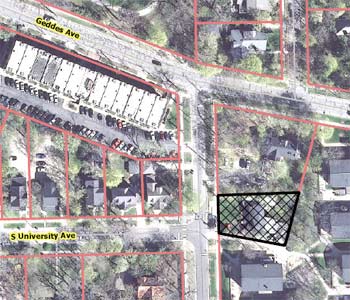
Aerial view showing the location of 515 Oxford, south of Geddes and at the eastern end of South University.
The request, recommended by the planning commission at its Jan. 23, 2014 meeting, is to rezone the parcel from R4A (multi-family dwelling) to R2B (two-family dwelling and student housing). Most of the surrounding parcels are zoned R2B, although the site immediately to the north is also zoned R4A. Also nearby is public land (PL) where the University of Michigan’s Oxford Houses complex is located.
The two-story house at 515 Oxford includes two one-story wings. It is currently a rental property with three units – a studio apartment, one-bedroom apartment, and four-bedroom apartment – and a maximum occupancy of 8 people. One of the units is in a former garage.
The proposal for a renovation would accommodate a maximum of 20 residents, including a required resident manager.
The building is notable because it was originally designed in 1940 by architect George Brigham, who used it as his home and architectural studio. He designed over 40 houses in Ann Arbor, including many in Arbor Hills and Barton Hills between 1936 and 1958.
To be given final approval, this item would require a second and final vote at a future meeting of the council. According to city planning staff, the timeline for this project is coordinated so that a site plan will be on the same council agenda as the second reading of the rezoning request. The site plan was approved by planning commissioners on April 15, 2014.
Land Use: Stapp Nature Area
The council’s May 5 agenda includes a resolution giving final approval to rezoning of land that’s been donated to the city by developer Bill Martin, founder of First Martin Corp. The 2.2-acre parcel at 3301 Traverwood Drive is being added to the adjacent Stapp Nature Area, near the Leslie Park golf course.
City staff recommended that the donated parcel be rezoned from R4D (multi-family dwelling) to PL (public land). The land reaches from Traverwood Drive to the Leslie Park golf course, south of Huron Parkway. Adding the land expands a corridor of natural areas and parkland. Stapp Nature Area, a 8.11-acre property with a mature native forest and small vernal pool, is adjacent to Tuebingen Park and has a connection to Leslie Woods.
The site is on the northern edge of a larger property that’s being developed by First Martin Corp. as Traverwood Apartments. That project received its final necessary approvals from the city council on Jan. 6, 2014.
First Martin has committed to creating a pedestrian access from the apartment complex to the nature area, which will be formalized with an access easement.
The city has a policy of rezoning city-owned land to PL (public land). This parcel will be differentiated as parkland by its inclusion in the city’s parks and recreation open space (PROS) plan, because it will become part of the Stapp Nature Area, which is already in the PROS plan.
This item was given initial approval at the council’s April 7, 2014 meeting.
Parks
Two items related to parks appear on the agenda: a contract for upgrades to play equipment in three parks; and approval of the purchase of two combination mower/snow-brooms.
Parks: Play Equipment
On the council’s agenda is a contract with Game Time c/o Sinclair Recreation for $132,000 to improve facilities at three parks. Arbor Oaks Park and Scheffler Park will have their play structures replaced, and North Main Park will be getting a tire swing and chess table.
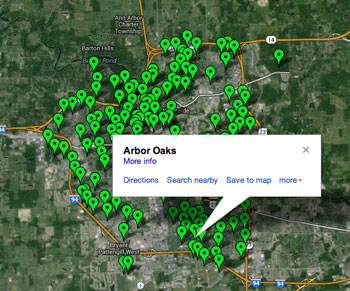
Arbor Oaks Park is located in Ward 3 in the southeast quadrant of the city. Image links to interactive map by the city of Ann Arbor.
Parks: Mowing/Snow-Removal
The council will be asked to approve the purchase of two 2014 Toro model 7210 commercial six-foot wide mower/snow broom combination units at $50,426 each for a total of $100,853.
The units have a mower deck that can be used in the summer months and can be converted in the winter into a tank-tread type unit with enclosed cab that accepts a rotating snow broom, a snow blower, or a plow blade.
The two Toros will replace two walk-behind mowers and three riding mowers.
Sidewalks
At the council’s May 5 meeting, a public hearing is being held on the proposed special assessment for sidewalk construction on Newport Road north of Wines Elementary School. The council voted at its previous meeting, on April 21, to direct the preparation of the roll and to set the public hearing.
The total amount to be special assessed for the Newport Road project is $49,746 – the entire cost of the project. But residents of the Newport Creek Site Condominium – who would not ordinarily be assessed, as their property isn’t adjacent to the sidewalk – have volunteered to contribute $10,228 to the project to help offset their neighbors’ assessments. Details of that arrangement are being finalized. The work is planned to be coordinated with a road resurfacing project for Newport Road, from Sunset to just south of Bird Road.
Environmental Commission Appointments
Appointments to the city’s environmental commission (EC) are on the May 5 agenda, having been postponed at the council’s April 21 meeting. All three that appeared on the April 21 agenda were re-appointments for currently serving members of the EC: Kirk Westphal, David Stead, and Susan Hutton.
However, the intention now is to substitute a resolution at the May 5 meeting that will not include Stead. In an email to other councilmembers from Sabra Briere (Ward 1) on May 2, she indicated that she’d be offering the substitute resolution, saying, “David Stead has decided that his life is busy enough he cannot do justice to serving on the commission.”
Postponement after initial appearance on the agenda is not unusual for appointments to the EC, because it allows the appointment to mimic the two-step nominate-confirm process for mayoral appointments. EC positions are nominated by the council as a whole. However, in the case of these appointments, Stead’s four previous terms on the commission would likely have been be a point of friction for some councilmembers.
Stead was among the first members to be appointed, on Sept. 18, 2000 – after the council established the commission in a resolution approved on April 3, 2000. And he has served continuously since that initial appointment. Stead also served on the city council representing Ward 5 from April 1993 through November 1994.
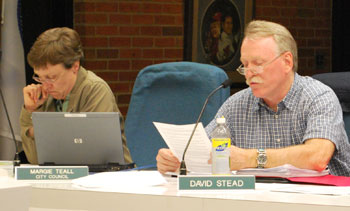
David Stead, right, reads a resolution he proposed at an environmental commission meeting in 2009. The resolution, which was approved, recommended removing Argo Dam. At left is Margie Teall, a city councilmember who also sat on the environmental commission at the time.
There are no term limits for Ann Arbor city boards and commissions, except those highlighted in the city charter as having a six-year maximum, but several councilmembers have expressed concerns about the length of service by some members of some boards and commissions preventing a broader range of participation in local governance. Most recently, the issue arose in connection with the re-appointment of Wayne Appleyard to the energy commission on Oct. 23, 2013. Also a factor in the 8-3 confirmation vote for Appleyard was his non-city residency.
Stead is vice president of Resource Recycling Systems. City council minutes show that the council has approved roughly $300,000 in contracts for consulting work by RRS for the city of Ann Arbor between 2007 and 2009.
Westphal is being put forward as the planning commission’s representative to the environmental commission. He currently serves as chair of the planning commission, which voted at its Jan. 23, 2014 meeting to recommend Westphal’s reappointment. Westphal did not participate in the vote on that recommendation.
Westphal, a Democrat, is contesting the Ward 2 seat to which Sally Petersen is not seeking re-election – because she is running for mayor. Nancy Kaplan, who’s currently a member of the Ann Arbor District Library board, is running for that same Ward 2 seat.
In 2013, mayor John Hieftje declined to nominate Jeff Hayner to serve on the public art commission, citing a policy against nominating candidates for city council to serve on city boards and commissions. Hayner ran for Ward 1 council against Sabra Briere that year – a race in which Briere prevailed.
Hutton was first appointed to the environmental commission in 2011 and is concluding her first three-year term.
Deer Herd Management
On the May 5 meeting agenda is a resolution that would direct the city administrator to partner with other organizations to develop strategies for deer management. The resolution also directs the administrator to report back to the city council by July 31, 2014 on the status of the partnership, including budget and timelines. The resolution, put forward by Jane Lumm (Ward 2), states that the desired outcome is a community-endorsed deer management plan.
Other organizations named in the resolution as potential partners include the Washtenaw County Parks and Recreation Commission, the University of Michigan, the Humane Society of Huron Valley, and the Michigan Department of Natural Resources Wildlife Division. A recent meeting of the Washtenaw County Parks and Recreation Commission included a discussion of deer herd management.
Updated: Washtenaw County commissioner Andy LaBarre has sent an email to the city council expressing his support for the resolution, and an indication that he will be putting forward a similar resolution for the board of commissioners to consider. [.pdf of LaBarre's email]
One metric for deer as a nuisance is traffic accidents they cause. While the number of traffic crashes involving deer has shown a slight downward trend in Washtenaw County, the number of vehicle-deer crashes in the city of Ann Arbor has shown a slight upward trend.

Since 2004, the number of vehicle-deer crashes in Washtenaw County has shown a slight downward trend. (Data from michigantrafficcrashfacts.org, chart by The Chronicle)
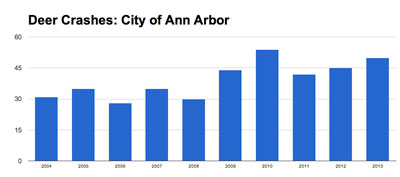
Since 2004, the number of vehicle-deer crashes in Ann Arbor has shown a slight upward trend. (Data from michigantrafficcrashfacts.org, chart by The Chronicle)
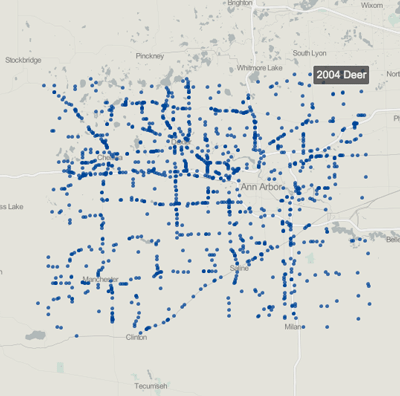
Deer-Vehicle Accidents in Washtenaw County by Year by Location (Data from michigantrafficcrashfacts.org, plotted and animated by The Chronicle at geocommons.com) Blue dots indicate the location of a deer-vehicle accident.
The Chronicle could not survive without regular voluntary subscriptions to support our coverage of public bodies like the Ann Arbor city council. We sit on the hard bench so that you don’t have to. Click this link for details: Subscribe to The Chronicle. And if you’re already supporting us, please encourage your friends, neighbors and colleagues to help support The Chronicle, too!




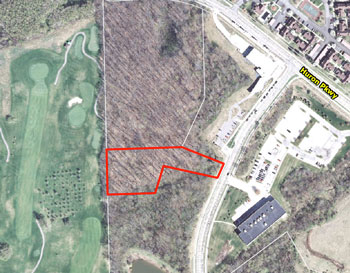
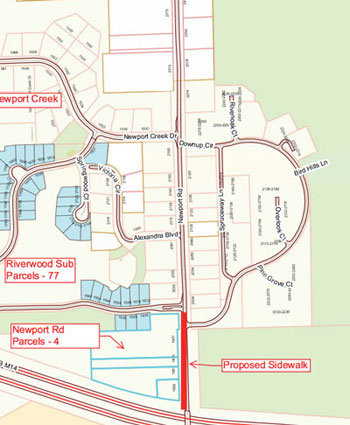
The article states: “There are no term limits for Ann Arbor city boards and commissions…” Section 5.17 (a) of the City Charter provides: “No person serving on such board continuously for six years shall be eligible to reappointment, until the lapse of three years.” The operative language being “such board” which follows a list of particular boards. The environmental commission is not one of the listed boards.
Some on Council believe that the Charter expresses a general goal of limiting the duration of service on boards that also should be applied to boards not specified. The City has many talented people who could be tapped to serve on these boards and commissions if we did not fall into the habit of reappointing the same people again and again.
Terms of service on boards can be staggered to insure that there is both continuity and fresh voices. Limiting the duration of service is not meant as a slight to any individual, but is meant to encourage more diversity in participation.
Re: [1] Yes, that’s inaccurate because it’s over-broad. I’ve inserted text in blue-face to bring it in line. By way of example, the park advisory commission is one of those boards that has term limits as a result of the charter provision cited.
Thanks to Council member Jane Lumm for her work on the deer population issue and for her bill which she will introduce to Ann Arbor City Council next Monday night.
As well as bringing destruction to the gardens and trees in our city, the herds pose a real threat to public health everywhere in Washtenaw county. Lyme disease carried by deer ticks is increasing and so are are the injuries caused by deer/automobile collisions.
Any solution, as Ms. Lumm suggests must be the result of inter governmental cooperation. It seems to me that the Michigan State Public Health Department should acknowledge this as public health issue and therefore part of its mandate to protect citizens by participating in any solution to this problem. The Public Health Departments of Washtenaw County and in the counties surrounding our county would do well in joining together to urge the State of Michigan to participate in funding solutions to the threats posed by deer.
An important part of of ending the destruction and disease caused by deer lies in greatly reducing the deer population in Ann Arbor and across the county. Their population here and across the nation are greater now then when our country was first settled. Deer are indeed beautiful, but they are also a threat to both of our environment and of our physical well being.
I agree with everything BLB has said. But we also have to be cognizant that the Department of Natural Resources is a major player. They have constrained hunters, especially with Antler Point Restrictions. See this page: [link]
This is a measure to keep hunters from shooting younger bucks so that some hunters may bring home bigger antler trophies.
Another management tool is antlerless deer permits. These are administered in a flexible fashion, depending on deer populations. See [link] Antlerless deer are females and very young males. The linked document explains the thinking and suggests that deer populations may be needed to “recover” so that there are plenty of hunting opportunities.
If we want to minimize intrusion of deer into our urbanized and suburban areas, we may need to bring some political effort into revising some of these guidelines, which are aimed at keeping a higher deer population. The suggestion that smaller more localized DMU (deer management units) should be employed might make a good start.
Deer are a species that has evolved to accept substantial predation. We have exterminated or limited most predators other than ourselves. It is not humane to suggest that they should not be hunted, as some will do. That can lead to starvation, disease, and conflict with humans.
This proposed CDM contract extension is approximatelyf $750,000!! Consider that in the past year Council has authorized the following:
1.Current on-going studies ALL related to storm and sewer water management
a.Sanitary Sewer Wet Weather Evaluation Project: $1,250,000
b.Upper Malletts Drainage Study: $ 215,000
c.Stormwater Hydraulic Model Calibration & Analysis Project : $ 900,000 (TO CDM)
Total Costs of On-going studies: $1,465,900
This $1.47 million DOES NOT include the current contract value with CDM, nor the excessive change orders issued too OHM (consultant on the SSWWE Study), OR the proposed $750k contract extension included in DS-1 Council Agenda.
When you fly up to 30,000 feet and see the big picture, you begin realize 3 basic facts:
1. This is a lot of money to JUST STUDY the same issue: WATER
2. The WATER all starts from the same spot…(precipitation and the river) and evenually all ends up in the same spot…. the river.
3. IT IS HIGH TIME TO SPEND TAX PAYER AND UTILITY PAYER MONEY ON FIXING OUR INFRASTRUCTURE AND NOT ON CONSULTANTS
4. City Staff has publically stated that the City can not afford the recommendatons of the Upper Mallets Study for 5 years.
How can the City justify continuing to fund Consultants and NOT infrastructure repairs?